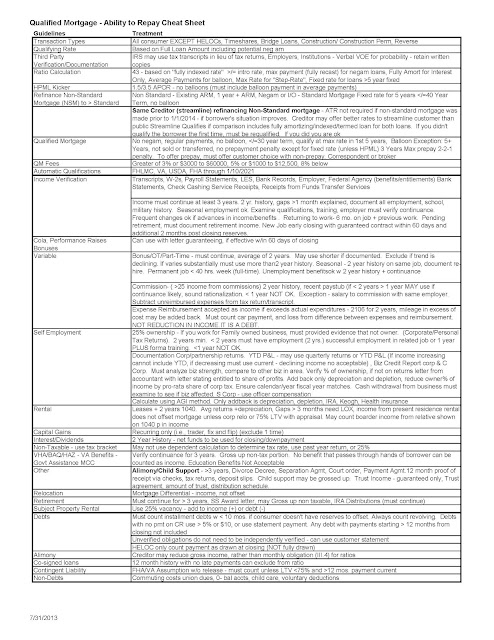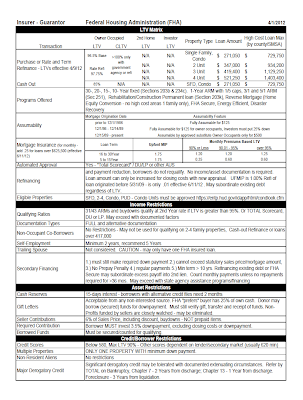We Are In the Same Business - Why the Divide?
In the conversations, news, editorials and blogs I follow I see a real philosophical divide between brokers and bankers. It grows more pronounced as rates rise and the regulatory dust settles revealing all the implications of the new rules. Bankers (correspondent lenders and banks) have a derisive view of brokers that seems to spring from a perception of unethical marketing practices. Brokers feel that bankers have an unfair regulatory advantage with respect to compensation. As expected, the position you take on these issues depends where you sit.
The Future of Mortgage Brokering
To contemplate "survival" or the "future of the mortgage broker" you must have a clear understanding of the roles these distinct business models play in the marketplace. Before there were institutional mortgage lenders who arranged financing by selling securities into the capital markets, banks, sellers and private lenders provided the sources for home financing. This financing often carried draconian terms; call provisions, short term balloons, and rarely extended more than 5 years. If your property was mortgaged, you had considerable worry about your ability to renegotiate at maturity, or whether the bank or seller would demand payment unexpectedly. To deal with these exigencies there was the mortgage broker, "mortgage agent" or "loan agent."
The sources for loans - banks, insurance companies, private lenders - weren't always easy to locate. These institutions also didn't necessarily have the capacity or desire to deal with the consumer. If the institution did go directly to the consumer, just as is true today, the borrower didn't have the expertise to negotiate and query loan terms to identify a good deal. The market need for someone to play the role of mortgage broker - an intermediary between lenders and customers - demonstrated itself in the media of the time.
What Value Does the Mortgage Broker Add? - A Marketplace of Transparent Terms and Customer Choice
Beyond simply facilitating the loan process, brokers should add value by seeking out products not necessarily available in a particular market. As the advertisement in the Willmar Tribune (Nov 12, 1895) shows, the loan agent proves value by showing the customer that there are multiple programs available from many different lenders; the broker brings new products to market.
In addition, the broker allows the customer to comparison shop the available terms. The unspoken advantage for the customer dealing with the loan agent here is that IT'S THE BANK that is likely to take advantage of you, so you should work with a broker who will be transparent. How DID THIS get turned around? Today the popular perception is that it's the broker who is dishonest. Clearly, this is where today's brokers have fallen furthest in delivering their value to the marketplace. Undisclosed fees, lack of process transparency, bait and switch loan offers all have contributed to this perception. Sadly, some of the outcry over unfair regulation stems from a desire to hold on to these less than transparent practices which, frankly, provoke understandable suspicion.
In the post-Civil War reconstruction period (1865-1885) credit demand grew, spawned by economic growth and investment. In these excerpts you see images and methodologies that are not that different from the solicitations you see today.
The creation of the government guaranteed mortgage and FNMA in the 1930's changed that, heralding the entry of a new business model - the mortgage banker - who competed with the banks to provide this financing. The first S&L crisis (when rates went to 18%, driving S&Ls with portfolios of 4% mortgages into insolvency) exposed the value of the mortgage banker's business model, selling fixed rate securities and passing interest rate risk on to the long-term investor. But the mortgage bankers are not really lenders. They are "proxy-lenders" who can make loans intended for resale on a delegated basis.
The Value-Added Service for Mortgage Bankers and Correspondents
Technically, the mortgage banker provides the same value as the mortgage broker, in terms of transparency: to be competitive with a set of proxy products, you have have to have a sharp price. In the secondary market where these proxy loans are sold, the pricing moves second by second and an entire year of marginal gains in loan sales can be wiped out in one bad day. For this reason, a mortgage banker's true cost - total net price when considering origination fees, points, servicing premiums and net warehouse interest margin - is irrelevant at the loan level. Some days you are ahead, and some days you are behind. Then there are expenses that you cannot quantify at the loan level: deficiencies, buybacks, insurance and hedging costs. The only true measure of your profitability is your ability to offer products in a relatively similar band as other proxy lenders. With this risk, why do mortgage bankers even want to be in this business?
The answer lies in the production of loan servicing and servicing rights. If a lender has the right to collect 0.375% - 0.50% annually on its portfolio of serviced loans, then the company can have long term viability regardless of the origination climate. $1 Billion in mortgages can generate $3.75 million in cash flow, which can support operations when originations start to flag.
The advantage the mortgage banker provides - in addition to a sharp price competitive with other proxy lenders - is the ability to control a transparent process. Lenders control the underwriting and funding process internally, whereas brokers have to rely on their correspondents for service delivery. Technically speaking, a mortgage banker should never lose the service delivery competition (who can close the loan faster?) to the mortgage broker.
Two Completely Different Business Models - There IS No Competition
If both business models adhere to their market derived functions, no conflict should ever exist between broker and mortgage banker. In fact, there should be an easy symbiosis: brokers should refer borrowers who are ideal proxy lender candidates to the proxy lenders - lenders should refer borrowers who need a variety of products outside the proxy lender's range to the broker.
Conflict only arises when the lender tries to act as a broker or the broker tries to act as lender.
In the early '00's many mortgage bankers used the secondary market to create a fictitious price-for-risk model allowing them to place outside the-box exceptions and sub-prime borrowers. This was not "proxy lending" as clearly defined by the guidelines in place, but was a manipulation of the due diligence cycle for short term gains. We all understand this now. As these loans came into wide distribution in 2005 and 2006, institutional investors began to push back as the poor loan quality was revealed. American Home Mortgage, the largest proxy lender at the time, literally collapsed in May of 2007 within 2 months of the completion of the quality control cycle. The remainder of the story we have all lived through. This short term manipulation of the due diligence cycle signaled lenders acting as brokers: trying to provide a market solution that didn't exist. Brokers, on the other hand, have been placing hard to qualify, credit impaired borrowers as a market defined business model.
On the other side, brokers capitulated to the proxy lender's behavior. Brokers began to represent themselves as "lenders" and "correspondents" using faux processes such as table-funding to create the illusion that the customer was dealing with a proxy-lender. Brokers used this illusion to justify inflating or concealing their origination fee income to the customer, while holding themselves out to customers as offering the "best price." While the principle of "buyer beware" should guide a consumer to vigorously validate market terms, customers do not possess the broker's expertise. When brokers act as lenders they abrogate their market role, which is to provide a transparent alternative to proxy lenders and product alternatives to bank lenders.
The 2007-09 contraction in the broker business, where 90% of brokers closed or went to work at banks or mortgage bankers, simply reflected this abrogation of duties. Brokers acting as lenders cannot subsist long term. It is a capitalist paradigm that your business model must follow its optimality. In times of high refinancing activity it may
appear possible because the broker provides the excess origination capacity that proxy lenders cannot afford to invest in.
To survive in the future brokers should look at the business model's successful past. Seek out products that are not widely available through lenders. Provide service niches. When providing proxy-lender products such as conforming loans, prepare to offer them at the sharpest possible price. "Be true to yourself" is a life aphorism for success. Brokers should not focus on their unnatural existence of the past 10 years, but on the future and innovating to meet the challenges of higher rates, tighter guidelines and regulation. Brokers were a force 150 years ago, long before the proxy-lenders existed. In a world of GSE reform, they may survive past them, too, if they are true to themselves.



+1876-1892,+April+19,+1888,+Image+1+%C2%AB+Chronicling+America+%C2%AB+Library+of+Congress.png)


